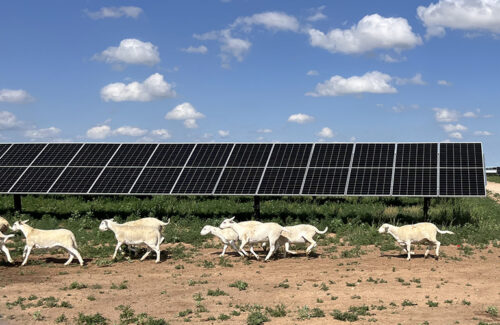A review conducted by SUN DAY campaign on data just released by the Federal Energy Regulatory Commission (FERC) reveals that the combination of solar and wind energy accounted for 88% of the newly added U.S. electric generating capacity in the first eight months of 2025. In August alone, solar energy provided two-thirds of the newly added capacity, marking the second consecutive year in which solar energy has maintained a monthly lead among all energy sources. Both solar and wind energy added more capacity than natural gas. Within three years, the combination of all renewable energy sources may exceed 40% of installed capacity.
Solar energy accounted for two-thirds of the newly installed power generation capacity in August, and 73% so far this year.
In the latest monthly Energy Infrastructure Update report (data as of August 31, 2025), the Federal Energy Regulatory Commission (FERC) stated that a total of 48 solar "units" with a total capacity of 2,702 megawatts (MW) were commissioned in August, accounting for two-thirds (66.4%) of the new generating capacity added during the month. This represents the second-largest data point for monthly solar capacity additions in 2025, second only to January, when 2,945 MW of new capacity was added.
The latest facilities include the 517.3 MW Outpost Solar and Energy Storage Project in Webb County, Texas; the 280.0 MW Gibson Solar Project in Gibson County, Indiana; the 254.0 MW Richley Energy Farm in Lake County, Tennessee; the 204.0 MW Luna Valley Solar Project in Fresno County, California; and the 200.0 MW Flat Fork Solar Project in Monroe County, Arkansas.
In the first eight months of 2025, the total installed capacity of 505 newly added large-scale solar facilities (i.e., >1 MW) reached 19,093 MW, accounting for 73.4% of all newly added power capacity.
Solar energy has been the largest source of monthly new power generation capacity for two consecutive years: from September 2023 to August 2025. During this period, the total utility-scale solar capacity increased from 91.82 GW to 156.20 GW. No other energy source has added as much new power generation capacity. For example, wind energy added 11.16 GW, while the net increase in natural gas was only 4.36 GW.
As of this month, renewable energy accounted for 88% of the newly added capacity.
In the first eight months of 2025, the combination of solar and wind energy (plus 4 MW of hydropower and 3 MW of biomass energy) accounted for 88.0% of the newly added capacity, while natural gas accounted for only 11.9%. The remaining net new capacity came from petroleum (20 MW) and waste heat (17 MW).
Solar and wind energy account for nearly a quarter of the utility-scale power generation capacity in the United States; all renewable energy sources combined account for more than a third.
The share of large-scale solar power generation in the total installed capacity (11.62%) is now nearly on par with that of wind energy (11.82%). If the recent growth rate persists, the capacity of large-scale solar power generation should match or even surpass that of wind energy in the next "Energy Infrastructure Update" report released by the Federal Energy Regulatory Commission (FERC).
Overall, wind and solar energy constitute nearly a quarter (23.44%) of the available utility-scale generating capacity in the United States.
In addition, nearly 29% of the solar capacity in the United States exists in the form of small-scale (e.g., rooftop) systems, which are not reflected in FERC's data. Including these additional solar capacities, solar + wind energy will account for more than a quarter of the nation's total electricity generation.

With the inclusion of hydroelectric power (7.59%), biomass energy (1.06%), and geothermal energy (0.31%), renewable energy now accounts for 32.4% of the utility-scale power generation capacity in the United States. If small-scale solar capacity is included, renewable energy now accounts for more than one-third of the total power generation capacity in the United States.
Solar energy remains the second-largest source of electricity generation capacity in the United States.
The Federal Energy Regulatory Commission (FERC) reported that between September 2025 and August 2028, the net "high-probability" increase in solar energy totaled 89,953 megawatts (MW) - this amount is almost four times the predicted net "high-probability" increase in wind energy (23,223 MW, the second fastest-growing resource).
FERC also predicts a net increase in hydroelectric power (566 megawatts) and geothermal power (92 megawatts), but a decrease of 126 megawatts in biomass power generation capacity.
Meanwhile, natural gas power generation capacity will increase by 8,481 megawatts, while nuclear energy will increase by 335 megawatts. Coal and oil power generation capacity are expected to decrease by 23,564 megawatts and 1,581 megawatts, respectively.
Overall, in the next three years, which is the remaining time of the Trump administration, the newly added "high-probability" power generation capacity of all renewable energy sources will reach 113,708 megawatts. On the other hand, the installed capacity of fossil fuels and nuclear energy will decrease by 16,329 megawatts.
If FERC's three-year forecast comes true, by early autumn 2028, large-scale solar energy will account for 17.1% of the installed power generation capacity in the United States, surpassing any other single energy source (natural gas at 40%). Furthermore, the capacity of all large-scale solar renewable energy sources will exceed 38%. If small-scale solar energy is also included (assuming its share in all solar energy remains at 29%), the share of renewable energy may exceed 41%, while the share of natural gas will drop to about 38%.
"Despite the hurdles created by the Trump administration and the Republican-controlled Congress, solar and wind continue to add more generating capacity than fossil fuels and nuclear," noted Ken Bossong, executive director of Solar Day. "And the Federal Energy Regulatory Commission expects the role of renewables to expand in the next three years, while the share of coal, oil, natural gas, and nuclear will all shrink."


